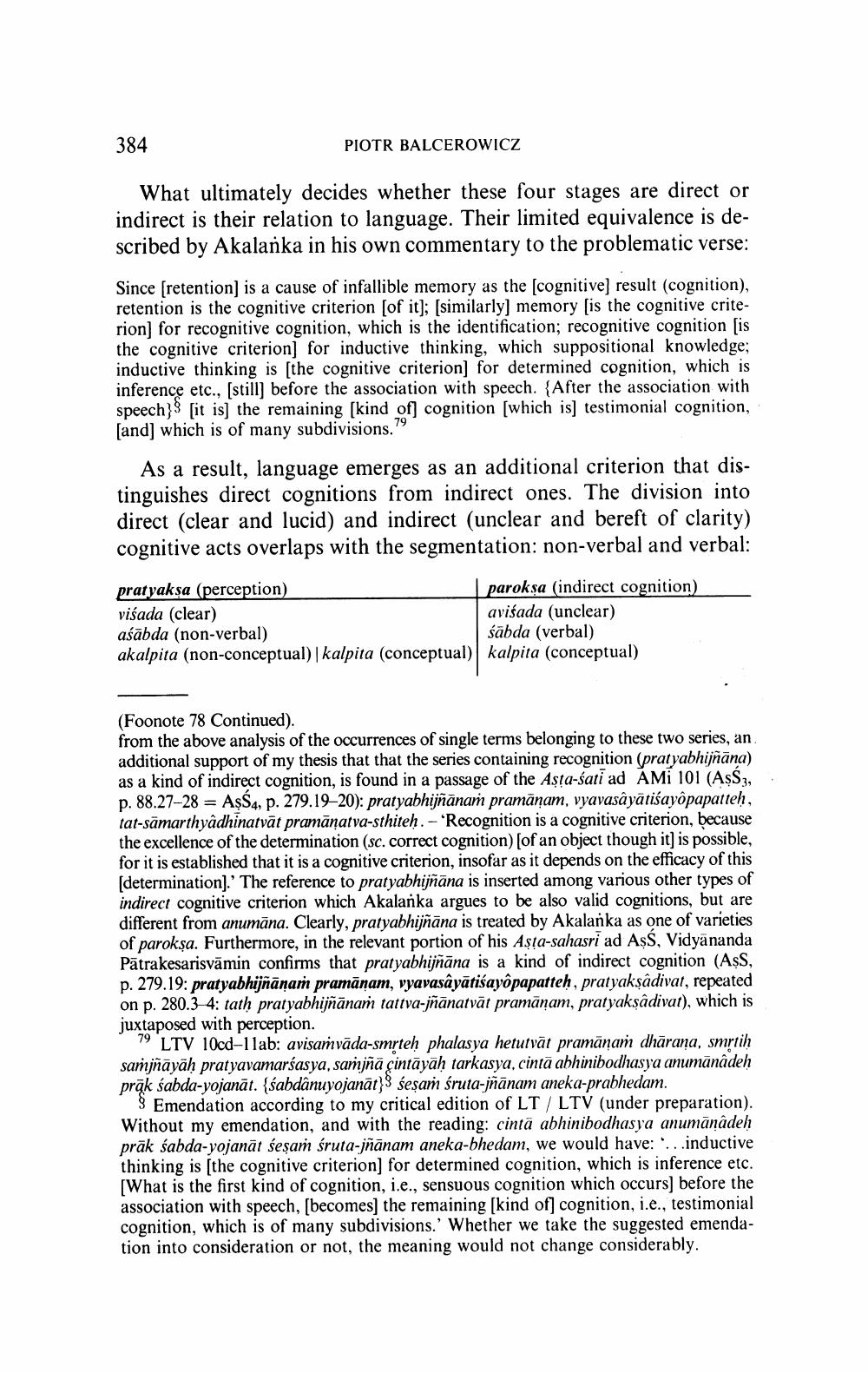________________
384
PIOTR BALCEROWICZ
What ultimately decides whether these four stages are direct or indirect is their relation to language. Their limited equivalence is described by Akalanka in his own commentary to the problematic verse:
Since [retention] is a cause of infallible memory as the [cognitive] result (cognition), retention is the cognitive criterion [of it]; [similarly] memory [is the cognitive criterion] for recognitive cognition, which is the identification; recognitive cognition [is the cognitive criterion] for inductive thinking, which suppositional knowledge; inductive thinking is [the cognitive criterion] for determined cognition, which is inference etc., [still] before the association with speech. {After the association with speech} [it is] the remaining [kind of] cognition [which is] testimonial cognition, [and] which is of many subdivisions.
As a result, language emerges as an additional criterion that distinguishes direct cognitions from indirect ones. The division into direct (clear and lucid) and indirect (unclear and bereft of clarity) cognitive acts overlaps with the segmentation: non-verbal and verbal:
pratyakṣa (perception)
parokṣa (indirect cognition)
visada (clear)
avisada (unclear) śābda (verbal)
asabda (non-verbal)
akalpita (non-conceptual) | kalpita (conceptual) kalpita (conceptual)
(Foonote 78 Continued).
from the above analysis of the occurrences of single terms belonging to these two series, an additional support of my thesis that that the series containing recognition (pratyabhijñāna) as a kind of indirect cognition, is found in a passage of the Asta-sati ad AMi 101 (AsS3, p. 88.27-28 AşŚ4, p. 279.19-20): pratyabhijñānam pramāṇam, vyavasâyātiśayôpapatteḥ, tat-sämarthyâdhinatvāt pramānatva-sthiteḥ. - 'Recognition is a cognitive criterion, because the excellence of the determination (sc. correct cognition) [of an object though it] is possible, for it is established that it is a cognitive criterion, insofar as it depends on the efficacy of this [determination].' The reference to pratyabhijñāna is inserted among various other types of indirect cognitive criterion which Akalanka argues to be also valid cognitions, but are different from anumana. Clearly, pratyabhijñāna is treated by Akalanka as one of varieties of paroksa. Furthermore, in the relevant portion of his Asta-sahasri ad AşŚ, Vidyananda Pātrakesarisvämin confirms that pratyabhijñāna is a kind of indirect cognition (AsS, p. 279.19: pratyabhijñāṇaṁ pramānam, vyavasayātiśayôpapatteḥ, pratyakṣâdivat, repeated on p. 280.3-4: tatḥ pratyabhijñānam tattva-jñānatvāt pramānam, pratyakṣâdivat), which is juxtaposed with perception.
79 LTV 10cd-11ab: avisamvada-smṛteḥ phalasya hetutvāt pramānam dhārana, smrtih samjñāyāḥ pratyavamarśasya, samjña cintayaḥ tarkasya, cinta abhinibodhasya anumanâdeḥ prāk sabda-yojanat. {śabdânuyojanat} sesam śruta-jñānam aneka-prabhedam.
3 Emendation according to my critical edition of LT/ LTV (under preparation). Without my emendation, and with the reading: cinta abhinibodhasya anumanâdeḥ prāk sabda-yojanāt seṣam śruta-jñānam aneka-bhedam, we would have: ...inductive thinking is [the cognitive criterion] for determined cognition, which is inference etc. [What is the first kind of cognition, i.e., sensuous cognition which occurs] before the association with speech, [becomes] the remaining [kind of] cognition, i.e., testimonial cognition, which is of many subdivisions.' Whether we take the suggested emendation into consideration or not, the meaning would not change considerably.




